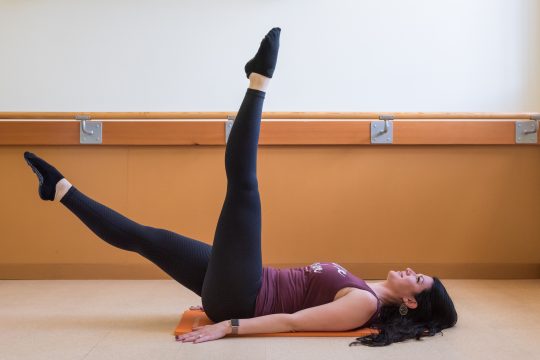
Flat back floor (FBF) is potentially my favorite abdominal exercise! Over the 18 years that The Dailey Method has been practicing this exercise it has continued to be refined, possibly more than any of the others, due to its complexities and its benefits. Yes, we’ve geeked out on it a bit-but with that attention to detail we have acquired tons of knowledge and have developed cuing to go along side it. The end result is helping you find your ideal position to work most effectively. When executed mindfully, FBF works to strengthen the smaller and deeper muscles that stabilize your entire core. This gives you a corset of core support from the inside out, front, side and back. There is a common misconception that your abdominals are your core- but your back and sides are also part of your core. Targeting these muscles is just as important as engaging the abdominals to achieve strength and stability for your spine and pelvis. FBF also directly targets your transverse abdominus, which is the deepest layer of our abdominal muscles. This layer is the most difficult abdominal muscle to connect with, especially if not in your ideal alignment. This layer is most accessible when you’re in a true neutral spine and pelvis. When people think “flat back” they generally think of removing the spinal curves and flattening their back to the floor. But that’s not where you can achieve the greatest benefit. We teach it with a neutral spine and pelvis while trying to maintain what’s called axial elongation. Axial elongation is the proper alignment of the head, spine and pelvis, with as much length as possible, so it provides optimum spacing between the joints during movement. When you are in alignment you have a better capacity to engage your muscles properly. Alignment of your spine is the key to getting your best benefit out of every exercise at The Dailey Method and in life. The cuing focus for this exercise is the back body integration into the ground. By energetically connecting your entire back body to the floor you have greater ability to fire up all of your trunk stabilizers.
Set up:
- Lay on your back with knees bent and feet flat on the floor. Rock your pelvis back and forth to find and then settle your pelvis and spine into neutral.
- Inhale length to your spine and try to reach sitz bones and the crown of your head as far away from each other as possible. This is what is defined above as axial elongation. You’re actively creating more space between each of your vertebrae while still maintaining optimal alignment.
- Press the energy of your back to the ground without changing the position. Feel your sacrum root down, your rib cage and shoulder blades press down, and the sides of your waist connecting into the floor. Your low back will likely still be slightly off of the floor but you are energizing the musculature of your entire back to the floor. By activating the muscles of the back body you create a corset of support. You’ll notice that the action of pressing down with the back body will naturally create a deeper engagement of the abdominal muscles.
- While maintaining stability, lift your legs up and straighten them out over your hips (if you have tight hamstrings keep the legs slightly bent.
- In counts of 2-4, lower one leg towards the floor as far as you can without losing alignment or engagement, and then alternate.
The simple action of maintaining focused energy of the musculature down towards the floor will have a positive strengthening impact. Taking the weight of the legs moving further away from your center line to challenge the engagement can progress with time as you get stronger and more aware of what muscles you are engaging.
Have fun!

